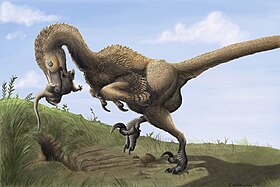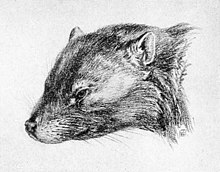Tar Heel/Coachman Formation
| Tar Heel/Coachman Formation | |
|---|---|
| Stratigraphic range: Early-Middle Campanian ~ | |
| Type | Formation |
| Unit of | Black Creek Group |
| Underlies | Bladen Formation |
| Location | |
| Region | |
| Country | |
The Tar Heel Formation, also known as the Coachman Formation in its southern region, is a Late Cretaceous (early to middle Campanian-aged) geologic formation in North Carolina and South Carolina. It preserves fossils, including amber dating back to the Cretaceous period. A locality known as Phoebus Landing, has been dated to 78.5-77.1 Ma.[1]
Likely deposited in estuarine and inshore marine conditions, it contains a high diversity of vertebrate remains. It has one of the most diverse dinosaur faunas known from the former landmass of Appalachia.[2]
Paleobiota
[edit]Ray-finned fish
[edit]Based on the Paleobiology Database & Stringer et al (2018). Some species are known only from otolith remains, which are indicated:[5][6]
| Genus | Species | Location | Material | Notes | Images |
|---|---|---|---|---|---|
| Albula | ?A. campaniana | Blue Banks & Auger Hole Landings, North Carolina | 263-378 otoliths | A bonefish. | 
|
| ?A. cf. A. ripleyensis | Blue Banks Landing, North Carolina | 1 otolith | |||
| A. sp. | Elizabethtown & Phoebus Landing, North Carolina | ||||
| Anomoeodus | A. phaseolus | Elizabethtown & Phoebus Landing, North Carolina | A pycnodontid pycnodont. | 
| |
| Ariidae indet. | Blue Banks Landing, North Carolina | 11 otoliths | A sea catfish of uncertain affinities. | ||
| Aulopidae indet. | Blue Banks Landing, North Carolina | 1 otolith | A flagfin of uncertain affinities. | ||
| Beryx | ?B. maastrichtiensis | Blue Banks & Auger Hole Landings, North Carolina | 55 otoliths | A potential relative of alfonsinos. | 
|
| ?B. zideki | 41 otoliths | ||||
| ?Congridae indet. | Auger Hole Landing, North Carolina | 1 otolith | An apparent conger eel of uncertain affinities. | ||
| Cylindracanthus | C. ornatus | Elizabethtown & Phoebus Landing, North Carolina | A fish of uncertain affinities. | 
| |
| Enchodus | E. petrosus | Elizabethtown & Phoebus Landing, North Carolina | An enchodontid aulopiform. | 
| |
| Gonostomatidae indet. | Blue Banks & Auger Hole Landings, North Carolina | 4 otoliths | A bristlemouth of uncertain affinities. | ||
| Hadrodus | H. priscus | Elizabethtown, North Carolina | A hadrodontid fish (considered a pycnodont or a semionotiform) | 
| |
| Hoplostethus | ?H. coffeesandensis | Blue Banks & Auger Hole Landings, North Carolina | 4 otoliths | A slimehead. | 
|
| Kokenichthys | K. ensis | Blue Banks Landing, North Carolina | 2 otoliths | An elopiform or osteoglossiform.[7] | |
| Lepisosteus | L. sp. | Elizabethtown & Phoebus Landing, North Carolina | A gar. | 
| |
| Megalopidae indet. | Blue Banks Landing, North Carolina | 1 otolith | A tarpon of uncertain affinities. | ||
| Osmeroides | O. weileri | Blue Banks Landing, North Carolina | 6 otoliths | An osmeroidid elopomorph. | 
|
| Paralbula | P. casei | Elizabethtown & Phoebus Landing, North Carolina | A phyllodontid elopomorph. | ||
| ?Pempheris | ?P. huddlestoni | Auger Hole Landing, North Carolina | 1 otolith | An apparent sweeper. | 
|
| Percoidei indet. | Blue Banks & Auger Hole Landings, North Carolina | 5 otoliths | A percoid. | ||
| ?Polymixia | ?P. cf. harderi | Blue Banks Landing, North Carolina | An apparent beardfish. | 
| |
| Protosphyraena | P. sp. | Elizabethtown, North Carolina | A pachycormid. | 
| |
| Pterothrissus | P. carolinensis | Blue Banks Landing, North Carolina | 67 otoliths | A pterothrissine bonefish. | 
|
| Saurodon | S. sp. | Phoebus Landing, North Carolina | A saurodontid ichthyodectiform. | 
| |
| Stephanodus | S. sp. | Phoebus Landing, North Carolina | A pycnodont. | ||
| Xiphactinus | X. audax | Elizabethtown & Phoebus Landing, North Carolina | An ichthyodectid ichthyodectiform. | 
| |
| X. vetus |
Reptiles
[edit]Dinosaurs
[edit]Ornithischians
[edit]An indeterminate hadrosauroid is known from Stokes Quarry.[2]
| Ornithischians of the Tar Heel/Coachman Formation | ||||||
|---|---|---|---|---|---|---|
| Genus | Species | Location | Notes | Images | ||
| H. foulkii | Hadrosaurus can be found throughout Late Cretaceous Appalachia.[2] |
 | ||||
| "Hadrosaurus" | "H." minor | Phoebus Landing, North Carolina | A small or juvenile hadrosaur.[2] | |||
| H.crassicauda | Hypsibema was first discovered in North Carolina from Sampson County, 1869, and described by Edward Drinker Cope. It was measured to be 12-17 meters, making it one of the largest hadrosaurids. |  | ||||
| Leptoceratopsidae[2][8] | Indeterminate | Sampson County, North Carolina | In 2016, a left maxilla was found of a dinosaur from the Leptoceratopsidae, of an unknown genus. | |||
| L. sp. | Phoebus Landing, North Carolina | Lophorhothon was discovered in the Mooreville Chalk Formation, Alabama. | ||||
Theropods
[edit]Indeterminate theropods, ornithomimosaurs, and maniraptorans are known from Stokes Quarry.[2]
| Theropods of the Tar Heel/Coachman Formation | ||||||
|---|---|---|---|---|---|---|
| Genus | Species | Location | Notes | Images | ||
| Appalachiosaurus[2] | A. montgomeriensis | Stokes Quarry, South Carolina | A large eutyrannosaur. | 
| ||
| cf. Coelosaurus[9] | Indeterminate | Phoebus Landing, North Carolina | An intermediate Ornithomimosaur | |||
| Dromaeosaurine[10] | Indeterminate | Sampson County, North Carolina | A large dromaeosaurid, larger than Saurornitholestes but smaller than Dakotaraptor. | |||
| Dryptosauridae[2] | Indeterminate | Phoebus Landing, North Carolina | A large eutyrannosaur part of an early lineage related to Dryptosaurus. | 
| ||
| S. langstoni |
|
The first evidence of dromaeosaurids in Appalachia was uncovered through S. langstoni specimens found at Stokes Quarry and Burches Ferry.[2] |

| |||
Crocodilians
[edit]Based on the Paleobiology Database:[5]
| Genus | Species | Location | Notes | Images |
|---|---|---|---|---|
| Bottosaurus | B. sp. | Stokes Quarry, South Carolina | An early caiman. | |
| Deinosuchus | D. rugosus (=Thecachampsa rugosa, Polydectes biturgidus, Polyptychodon rugosus) | Phoebus Landing, Clifton Farm & Elizabethtown, North Carolina
Stokes Quarry, South Carolina |
An alligatoroid, one of the largest known crocodilians. | 
|
Turtles
[edit]Based on the Paleobiology Database:[5]
| Genus | Species | Location | Notes | Images |
|---|---|---|---|---|
| Adocus | A. beatus | Phoebus Landing, North Carolina
Stokes Quarry, South Carolina |
An adocid. | 
|
| Bothremys | B. cooki | Phoebus Landing, North Carolina | A bothremydid side-necked turtle. | |
| Chedighaii | C. barberi | Phoebus Landing, North Carolina | A bothremydid side-necked turtle. | |
| C. hutchinsoni | ||||
| Corsochelys | C. bentlyi | Stokes Quarry, South Carolina | A sea turtle, likely a dermochelyid. | |
| Euclastes | E. wielandi | Stokes Quarry, South Carolina | A pancheloniid sea turtle. | 
|
| Osteopygis | O. emarginatus | Phoebus Landing, North Carolina | A macrobaenid. | |
| ?Taphrosphys | ?T. dares | Phoebus Landing, North Carolina | A bothremydid side-necked turtle, taxonomic placement disputed. | |
| Toxochelys | T. sp. | Stokes Quarry, South Carolina | A toxochelyid sea turtle. | 
|
| "Trionyx" | "T." halophilus | Phoebus Landing, North Carolina | A stem-softshell turtle, likely not an actual member of the genus Trionyx. | |
| "T." priscus | Stokes Quarry, South Carolina |
Plesiosaurs
[edit]| Genus | Species | Location | Notes | Images |
|---|---|---|---|---|
| Elasmosauridae indet. | Elizabethtown, North Carolina
Stokes Quarry, South Carolina |
An elasmosaurid. |
Squamates
[edit]| Genus | Species | Location | Notes | Images |
|---|---|---|---|---|
| Halisaurus | H. sp. | Phoebus Landing, North Carolina | A halisaurine mosasaur. | 
|
| Platecarpus | P. sp. | Phoebus Landing, North Carolina | A plioplatecarpine mosasaur. | 
|
| Prognathodon | P. sp. | Phoebus Landing, North Carolina | A mosasaurine mosasaur. | 
|
| Tylosaurus | T. sp. | Elizabethtown & Phoebus Landing, North Carolina
Stokes Quarry, South Carolina |
A tylosaurine mosasaur. | 
|
Mammals
[edit]Based on the Paleobiology Database:[5]
| Genus | Species | Location | Notes | Images |
|---|---|---|---|---|
| Cimolomys | C. sp. | Elizabethtown, North Carolina | A multituberculate. | 
|
References
[edit]- ^ Longrich, Nicholas R. (2016). "A ceratopsian dinosaur from the Late Cretaceous of eastern North America, and implications for dinosaur biogeography". Cretaceous Research. 57: 199–207. Bibcode:2016CrRes..57..199L. doi:10.1016/j.cretres.2015.08.004.
- ^ a b c d e f g h i j Brownstein, Chase D. (2018-02-08). "The biogeography and ecology of the Cretaceous non-avian dinosaurs of Appalachia". Palaeontologia Electronica. 21 (1): 1–56. doi:10.26879/801. ISSN 1094-8074.
- ^ a b NCSM Paleontology Database
- ^ Schwimmer, David R.; Weems, Robert E.; Sanders, Albert E. (2015). "A Late Cretaceous Shark Coprolite with Baby Freshwater Turtle Vertebrae Inclusions". PALAIOS. 30 (9/10): 707–713. ISSN 0883-1351.
- ^ a b c d Czaplewski, John J. "PBDB Navigator". paleobiodb.org. Retrieved 2024-10-10.
- ^ Stringer, Gary L.; Clements, Don; Sadorf, Eric; Shannon, Kevin (2019). "First Description and Significance of Cretaceous Teleostean Otoliths (Tar Heel Formation, Campanian) from North Carolina". Eastern Paleontologist. 4: 1–22. ISSN 2475-5117.
- ^ Stringer, Gary L.; Sloan, James Carson (2023-05-25). "First Cretaceous teleostean otolith assemblage (Arkadelphia Formation, upper Maastrichtian) from Arkansas, USA, early Gadiformes, and the Western Interior Seaway". PaleoBios. 40 (3). doi:10.5070/P940361192. ISSN 2373-8189.
- ^ Brownstein, Chase D. (2018-04-05). "Diversity of raptor dinosaurs in southeastern North America revealed by the first definite record from North Carolina". PeerJ Preprints. doi:10.7287/peerj.preprints.26829v1.
- ^ Baird D., and Horner, J., 1979, "Cretaceous dinosaurs of North Carolina" Brimleyana 2: 1–28
- ^ Brownstein, Chase D. (2018-12-01). "A large dromaeosaurid from North Carolina". Cretaceous Research. 92: 1–7. Bibcode:2018CrRes..92....1B. doi:10.1016/j.cretres.2018.07.006. ISSN 0195-6671. S2CID 135459468.
- ^ Brownstein, Chase D. (2018). "The distinctive theropod assemblage of the Ellisdale site of New Jersey and its implications for North American dinosaur ecology and evolution during the Cretaceous". Journal of Paleontology. 92 (6): 1115–1129. Bibcode:2018JPal...92.1115B. doi:10.1017/jpa.2018.42. ISSN 0022-3360.



